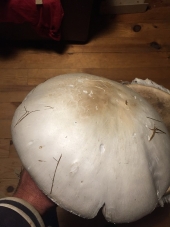So, I made some large slurries of Agaricus campestris a month ago and drenched the mulch around my raised gardens and fruit trees with it.
Today a large clump of campestris mushroom fruit has appeared from the bottom of the
compost bin (where I frequently dig out the rich soil), a few feet away from the nearest spot where I applied the slurry.
In many decades of living here and having a bin there, we've never had these mushrooms anywhere near this area or at all this time of year (40C).
I'm pretty sure the only explanation is that ants living in the dry mulch inside the bin (coarse palm fronds and lots of green tree prunings), ventured out and harvested the mycelium slurry and stored/farmed it in their nest.
The bin gets regular watering being adjacent to the gardens and the mushrooms are very blackened by the hot temperatures.
-
I'd like to repeat this accidental ant-cultivation experiment, but with parasol mushrooms - which are delicious and easy to forage, but seem to grow exclusively with the help of ants.





